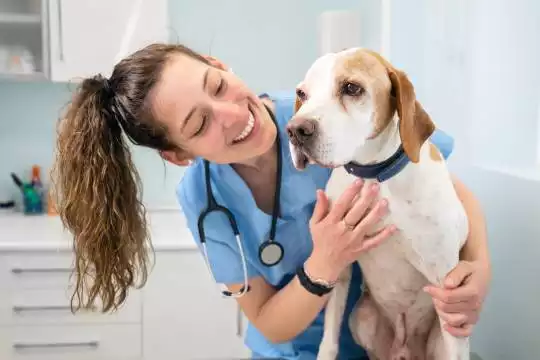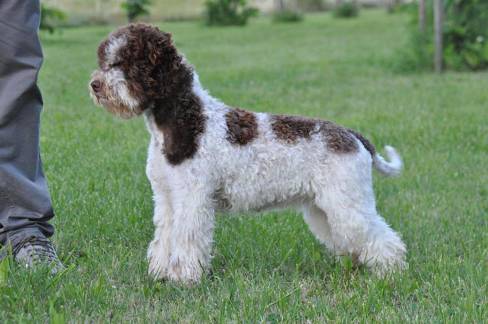Did you know your dog can develop frostbite when it’s freezing cold outside? It’s true! Just like us, our dogs can develop frostbite on any tissue that’s exposed to severe cold. In this article, we’ll cover all aspects of frostbite—from what it is, how it’s caused, how to treat it and how you can prevent your fur baby from developing this painful condition in the first place. We’ll even take a look at can dogs get frostbite on their noses.
Connect with a verified veterinarian in minutes. Licensed vets are available 24/7 to answer your questions. No need to worry about your furry family member.
What is Dog Frostbite?
Dog frostbite temperature generally is any temperature below 32 F (0 C). When it’s this cold, blood vessels close to the skin’s surface begin to constrict, which acts to help keep the body’s core temperature up, to keep the body warm. Blood is diverted from the extremities, which includes the nose, ears, paws, pads, tail, etc. of your fur baby. Instead, the heat is moved toward the core to keep your pup warm. If tissue, or the body, is exposed to severe cold temperatures for too long, the reduced blood flow to the extremities allows tissue to freeze. And we mean literally freeze. This leads to frostbite and tissue damage, including dog frostbite ears and more.
Frostbite generally happens on those areas that are farthest away from the heart and/or in tissues with large areas exposed to the cold.
Some types of dogs are more prone to developing frostbite than others, too. It’s important to note that any type of dog breed can develop this condition, including dogs such as Alaskan Malamutes and Siberian Huskies. Dogs most susceptible to frostbite include:
- Puppies
- Short-haired dogs
- Small dogs
- Senior dogs
- Dogs with metabolic and/or heart conditions
- Dogs with pre-existing health issues
- Any dog that has trouble staying warm
Each of these dog types can have a hard time regulating their body temperature in freezing weather. While frostbite is not usually a life-threatening condition, it can be quite painful when the tissue comes back to normal temperature. Skin will become reddened and swollen, and may even begin to peel, leading to ulcers and blisters of the skin. If frostbite is severe, the tissue will become blackened, which can lead to gangrene and death of the tissue in that area. At this point, amputation may be needed to keep the infection from spreading.
How Long Can Dogs Be Out in the Snow?
That’s a good question, but a better question to ask is what type of weather conditions can cause frostbite in dogs? Let’s take a look! It’s not only the snow and temperatures that can bring on frostbite. The environmental conditions that also determine how your pup will be affected in the cold include:
- Dampness: any type of moisture (rain, snow, heavy fog) that soaks into your fur baby’s coat can chill him very quickly. This is true even if it’s not very cold.
- Cloud cover: you know how it’s dark on cloudy days? They usually feel colder to use than sunny days. It works the same way for your canine companion. And when the sun’s hiding behind the clouds, he isn’t able to soak up that nice, warm solar energy pups love and use to stay warm.
- Wind chill: if there’s even a slight breeze on a very cold day, it can quickly go through your dog’s coat and reach his skin, making him feel cold. Wind keeps your dog’s fur from working as insulation, which leaves him vulnerable becoming chilled more easily.
- Your dog’s level of activity: on cold, dreary days, most dogs tend to curl up in the warmest spot they can find. If your dog’s outside and curled up tight, that’s a sure sign he’s cold. On the other hand, if he’s playing outdoors for a little bit in the cold, he should be OK, as the activity will help him stay warm in the colder air.
Generally, when temperatures are around 45 F, your pup will be OK, as long as he’s healthy and not out for hours at a time. However, once the temperature gets lower, falling below 32 F, then many dogs will feel cold and even begin to shiver. If you have a small dog, a dog with short fur, one who is young or old, or has health issues, then they shouldn’t be out longer than they need for going potty. When temperatures fall below 20 F, all dogs will feel it and can develop hyperthermia and frostbite.
They should only be out long enough to do their business and then come back inside where it’s warm.
This is the right time to remind all pet parents that no dog should be left out in the cold unattended when it’s very cold outside. It’s important to monitor your fur baby at all times, until he comes back in the house. If you see him outside showing any signs of hypothermia, then he’s been out too long. Bring him in and help him get warmed up.

Review symptoms, medications & behavior to keep your pets healthy with a Vet Online in just minutes.
Ask a Vet Live NowDog Frostbite Symptoms
Frostbite is sometimes difficult to find, especially if your fur baby has long hair. And sometimes it can take days before symptoms even become visible. Before your pup even develops frostbite, he’ll likely show signs of hypothermia, which is when his body temperature becomes too low. Mild hypothermia symptoms can include:
- Lethargy
- Hunching of the body
- Shivering
- Cold paws, ears, tail and nose
Moderate signs of hypothermia can include:
- Stiff muscles
- Lack of coordination
- Shivering stops
- No long responsive
Severe signs of hypothermia can include:
- Pale/gray gums
- Fixed, dilated pupils
- Collapse
- Coma (completely unresponsive)
The milder to moderate symptoms of hypothermia are the ways your canine companion’s body works to maintain his body heat. However, if your dog shows severe signs of hypothermia, this is an emergency and he must be taken to the vet immediately. When your fur baby comes in from outside, it’s important to check your dog’s tail, paws (including the pads and in between the pads), his nose, ear tips, his abdomen and chest, etc. Pads are generally the first area to develop frostbite.
Diagnosis of Frostbite in Dogs
If you’re worried your dog could have frostbite or shows some of the signs and symptoms above, then it’s time to call the vet. Your vet will perform a thorough physical exam, once he’s done a medical history. The vet may also order blood or urine tests to see if your fur baby’s organs have been affected.
Dog Frostbite Treatment
You can even start to treat frostbite at home, before you see the vet. This method can be used for dog frostbite paws treatment or any other affected body tissue:
1). Take him to a warm, dry room as soon as possible.
2). If your fur baby has hypothermia, then treat this first by wrapping his body in warm, dry towels or blankets. You can also try wrapping hot water bottles in towels and putting these near him.
3). Remember: NEVER RUB OR MASSAGE THE AFFECTED TISSUE.
4). And if you’re outdoors, then don’t warm the tissue that’s been frostbitten if there’s no way to keep the area warm. The reason is that refreezing the tissue will damage it even worse.
5). Slowly warm the affected tissue with warm, not hot, water. The water should feel comfortable to your touch—nothing warmer. Water that’s too hot can cause additional damage. The warm water can be applied to your dog’s body with compresses or by soaking the area in a bowl of warm water. Never use direct heat (such as a heating pad or hair dryer) to warm your dog. This is extremely dangerous and could cause severe harm.
6). Once the area is warmed up, then pat it dry very carefully and do not rub your fur baby with towels or your hands.
7). On the way to the vet’s office, you can keep your pup warmed by wrapping him in dry blankets or towels. These can be warmed in the dryer before placing them on your fur baby.
8). Avoid giving your dog any type of pain medication, unless your vet has told you to do so. Pain-relieving medications meant for humans are toxic to dogs, including acetaminophen, ibuprofen, naproxen, and aspirin.
Vet’s Treatment of Your Dog’s Frostbite
The vet’s treatment will depend on the severity of the frostbite your dog has suffered. Your pup may also require additional treatment for hypothermia or even shock. You’ll need to understand that thawing tissues is very painful, so the vet will more than likely give your fur baby pain medication. Antibiotics may also be necessary and are used to keep your dog from developing secondary bacterial skin infections, especially if the tissue has begun to die. In the worst cases, the vet may need to amputate the affected body part.
What’s the Prognosis if Your Dog Has Been Frostbitten?
This will depend on how badly your dog has been injured. In cases of mild frostbite, the good news is that damage is rarely permanent. More severe cases can cause permanent disfiguration or damage to tissue, and as noted earlier, these types of cases can lead to amputation of dead tissue.
Prevention of Dog Frostbite
In all cases, the best way to keep your fur baby from develop frostbite is to keep him safe and warm. Don’t leave him outside unattended when temperatures are 32 F or lower. You can also buy your pup some cold weather gear! You can find dog boots (for all four feet), dog parkas, sweaters and more! Cold weather gear will help protect your dog’s more vulnerable areas from freezing. And remember, if your canine companion has any type of health issue, such as diabetes, heart issues, etc. then he’s at higher risk of frostbite.
It’s OK to take your healthy dog out to play on cold days, but you both need to keep exposure to the cold to a minimum when temperatures are 20 F and below. Go out for a quick came of chase the snowball, then you both come back in, dry off, and enjoy a nice warm snack!
Connect with a verified veterinarian in minutes. Licensed vets are available 24/7 to answer your questions. No need to worry about your furry family member.

Kim
Kim is a talented author, who loves animals especially dogs. She engaged in writing books and articles relating to animals a decade ago. Kim resides in Chicago with her husband and son. The family is the proud owner of a dog and a parrot (Jack and Lily). Kim wanted more than these two pets, but her husband put his foot down... She often visits elementary schools to talk to the kids about what she learned about pets and how they could learn from them.
Review symptoms, medications & behavior to keep your pets healthy with a Vet Online in just minutes.
Ask a Vet Live Now



